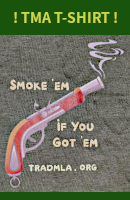Back in the mid-'90s I "pre-inherited" about a case of various old powders one of the older members of my home club had accumulated over the years. Most of it was shot over a chronograph to see just what some of the older powders were capable of, velocity-wise. There were several cans from the California Powder Works in the lot; I was looking forward to testing it as it was one mentioned by name in the account books of an ancestor who had a side-gig as a market hunter. The stuff I got was all marked as a sporting powder, rather than the more-commonly-seen blasting powder.
My most-shot flintlock then was a cut-down Pedersoli Brown Bess. I had a good load worked up that gave about 1,300 fps using a .735" round ball. Most of my comparisons were done with this gun. I'd use the same measure, and fire (typically) at least 5 shots for purposes of comparision.
My default powder of the day was Elephant, a powder I still see and hear people complaining about how it was such a dirty powder. . .but the CPW made Elephant look good. It wasn't graphited (no surprise there as most powders of the day weren't). It also wasn't glazed, and wasn't even particularly well-made in the first place. It was nominally 1F: over time you'd expect the granules to be broken and getting smaller--but most of them were large enough they should have been screened out as too large for 1F.
Spilled on a piece of paper, the stuff ignited well. Loaded in my Bess, it gave consistent velocities in the 850 fps range. The fouling was horrendous. I tried a different can, same thing. I tried a can labeled as a pistol powder (3F); that got the velocities up over 900 fps, barely. (For folks not familiar with a variety of powders, that same volume of the repackaged fireworks lifting powder that was on the market around 1999 powder would typically give just over 1,000 fps.)
Kinda neat that they were making powder in California, but I'll bet their primary market was hard-rock miners, with sporting shooters just being an afterthought.




